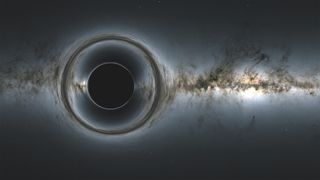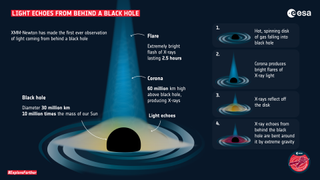Space telescopes spot light 'echoing' from behind black hole for the first time

For the first time ever, scientists have seen the light from behind a black hole.
Black holes are regions in space-time where gravity's pull is so powerful that not even light can escape its grasp. However, while light cannot escape a black hole, its extreme gravity warps space around it, which allows light to "echo," bending around the back of the object. Thanks to this strange phenomenon, astronomers have, for the first time, observed the light from behind a black hole.
In a new study, researchers, led by Dan Wilkins, an astrophysicist at Stanford University in California, used the European Space Agency's XMM-Newton and NASA's NuSTAR space telescopes to observe the light from behind a black hole that's 10 million times more massive than our sun and lies 800 million light-years away in the spiral galaxy I Zwicky 1, according to a statement from ESA.
Video: Milky Way's core overflows with colorful threads in new X-ray panorama

This study began with the researchers' desire to expand our understanding of black hole coronas, which are the source of the X-ray light that often radiates from the vicinity of these objects. . Bright flares of X-ray light are emitted by gas that falls into black holes from their accretion disks, the disks of dust and gas that surround and "feed" these objects.
The team spotted an X-ray flare in I Zwicky 1 that was so bright that some of the light reflected on the gas falling back into the black hole. When that reflected light was bent around the back of the black hole by the object's extreme gravity, the team was able to spot it using the ESA and NASA space telescopes.
The team didn't just observe this light, which is the first time it has been directly observed like this; they also took note of how the X-ray light changed color as it bent and moved around the back of the black hole. By observing the light's journey around the back of the black hole, the researchers hope to understand more about what really goes on that close to these gravitational vortexes.
Get the Space.com Newsletter
Breaking space news, the latest updates on rocket launches, skywatching events and more!
Following this groundbreaking study, the team aims to create a 3D map of the black hole's surroundings, according to the statement. They also hope to better understand black hole coronas and explore how the corona of a black hole is capable of producing these bright X-ray flares.
This work was described in a study published July 28 in the journal Nature.
Email Chelsea Gohd at cgohd@space.com or follow her on Twitter @chelsea_gohd. Follow us on Twitter @Spacedotcom and on Facebook.
Join our Space Forums to keep talking space on the latest missions, night sky and more! And if you have a news tip, correction or comment, let us know at: community@space.com.

Chelsea “Foxanne” Gohd joined Space.com in 2018 and is now a Senior Writer, writing about everything from climate change to planetary science and human spaceflight in both articles and on-camera in videos. With a degree in Public Health and biological sciences, Chelsea has written and worked for institutions including the American Museum of Natural History, Scientific American, Discover Magazine Blog, Astronomy Magazine and Live Science. When not writing, editing or filming something space-y, Chelsea "Foxanne" Gohd is writing music and performing as Foxanne, even launching a song to space in 2021 with Inspiration4. You can follow her on Twitter @chelsea_gohd and @foxannemusic.